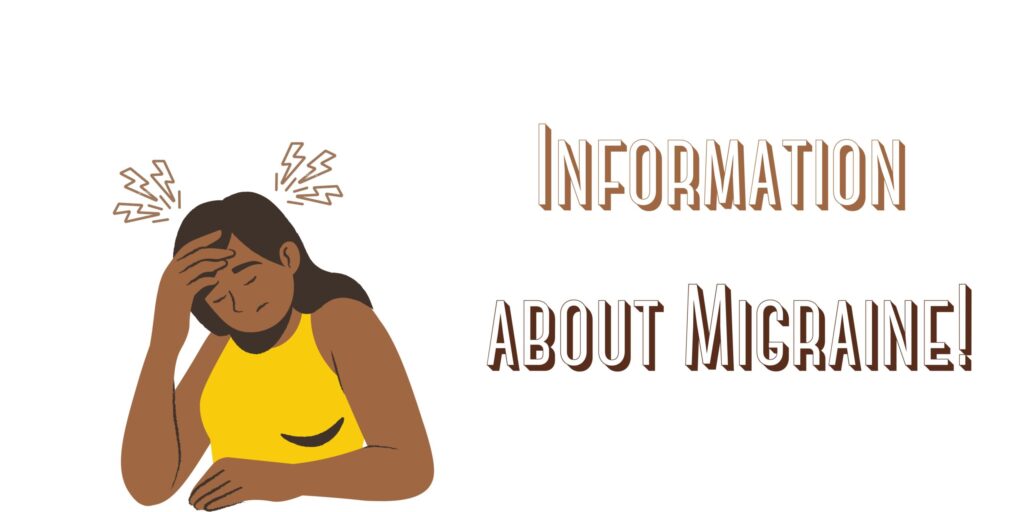Causes of migraine
The causes of migraine, along with symptoms and treatment, are addressed carefully in this article. Most of the time, a migraine headache feels like throbbing pain on one side of the head. A lot of people also feel sick, throw up, and are more sensitive to light and sound.
Five percent of women, along with 15 percent of men, become ill with migraines, a frequent medical disease. They usually start when a person is a young adult. Migraine attacks can last for hours or even days, and the pain can be so bad that it makes it difficult to do everyday things.
Some people feel something called an aura before or along with their headache. Auras can cause strange things to happen to the eyes, like light flashes or blind spots. They can also cause strange things to happen to the body, like tingling on one side of the arm or face, leg, or trouble speaking.
Some medications for migraines can help prevent them and make them less painful. Taking the proper medications, self-help treatments, and changes to your lifestyle may help.
Symptoms of migraine
Migraines can happen to both kids and adults. They can go through four stages: the prodrome, the aura, the attack, and the post-drome. Not everyone with migraines goes through all of these stages.
- Prodrome
One or two days before you get a migraine, you may notice slight changes that tell you it’s coming, like a lot of yawning, constipation, retention of fluid, changes in mood, from sadness to euphoria, stiff neck, frequent urination, and food cravings.
- Aura
Auras can happen before or during migraines for some people. Auras are reversible signs of the nervous system. Mostly, they are visual, but other things can also cause them. Each symptom usually starts slowly, gets worse over a few minutes, and can last up to an hour.
Here are some examples of migraine auras: difficulty speaking and things you can see, like bright spots, different shapes, or flashes of light. Face or one side of the body feels weak or numb, arms or legs that feel like they are on pins and needles, and vision loss are also other examples.
- Attack
If you don’t do anything to stop it, a migraine can last anywhere from 4 to 72 hours. Migraines can happen to different people at different times. Migraines can occur rarely or more than once a month.
Migraine can make you feel sick and puking, with pain on one side of your head most of the time, but often on both, having a heightened response to sound, and light, sometimes touch and smell, and throbbing or pulsing pain.
- Post-drome
After a migraine attack, you may feel tired, confused, and worn out for up to a day. Some people say they are happy. A sudden movement of the head could temporarily bring back the pain.
Sensory stimuli are included in the causes of migraine. Migraines can be caused by loud sounds and bright or flashing lights. Some people get migraines when they smell strong smells like perfume, paint thinner, or second-hand smoke.
Causes of migraine
Stress at home or work may trigger migraines. Some people can get migraines if they don’t get enough sleep or sleep too much. Migraines can be triggered by strenuous physical effort.
Drinking is one of the causes of migraine. These include drinking too much alcohol, especially wine, and caffeine from things like coffee. A change in the weather or barometric pressure could bring on a migraine.
Oral contraceptives and blood vessel dilation drugs like nitroglycerin can make migraines worse. Migraines can be caused by salty foods, aged cheeses, and foods that have been processed. Skipping meals may also be harmful.
Additives in food can cause Migraine. Aspartame is a sweetener, and monosodium glutamate (MSG) is a preservative – these are found in many foods. You are prone to get migraines if someone in your family does.
Migraines can begin at any age, but most people get them when they are going through puberty. Migraines tend to be the worst and happen the most in your 30s. After that, they get less harmful and occur less often over the next few decades.
Prevention and treatment
Migraines are often wrongly labelled and not treated. If you get migraines often, write down when they happened and how you dealt with them. Then, make an appointment to talk to your doctor about your headaches.
Women’s hormonal changes are included in the causes of migraine. Many women get headaches when their oestrogen levels change, like before or during pregnancy, menstruation, or menopause. Oral contraceptives and other hormonal drugs could also make migraines worse. But some women say that taking these medicines makes their migraines less often.
Even if you’ve had headaches before, you should see a doctor if the pattern changes or if your headaches vary slightly more than they usually do. Consult with your physician immediately if you have any of the following symptoms that could mean a more serious health problem: Headaches that start after age 50, A sudden, severe headache like the sound of thunder, A constant headache that gets worse when you work out, strain, cough, or make a sudden movement, and Headaches after a blow to the head. A stroke can be caused by a headache with fever, double vision, seizures, confusion, a stiff neck, numbness, or weakness in any body part.
To avoid migraines, please do the following:
- Learn ways to deal with stress, like yoga, relaxation training, meditation, or breathing with awareness.
- Every night, get seven to nine hours of sleep.
- Regular exercise will help you keep a healthy weight.
- Eat food on a regular schedule. It would be ideal if you didn’t skip meals. Drink a lot of water.



